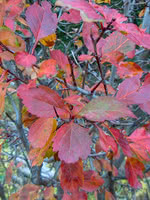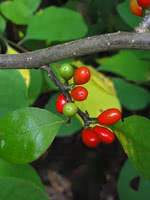Mon-Fri 9am - 5pm Mountain time
Black Hawthorn vs Spicebush
Crataegus douglasii
Lindera benzoin
NOT AVAILABLE THIS SEASON - MIGHT RETURN
NOT AVAILABLE THIS SEASON - MIGHT RETURN
Black Hawthorn is a versatile plant that is native to wetlands and other areas with moist soils, but can also tolerate dry soils. This plant can be grown as a short shrub, or a tree reaching 30 feet tall.
Black Hawthorn is valued for erosion control and attracting pollinators. It also makes an attractive flowering ornamental that can be planted as a specimen or pruned as a hedge. It is commonly used in shelterbelts.
The Spicebush is an unique ornamental shrub that blooms with vibrant yellow flowers and bright green foliage. The foliage goes from green to yellow in the autumn, adding fall interest to your garden.The plant is dioecious, meaning that you will need male and female plants in order to harvest it’s red berries. Berries are only produced on female plants. The berries themselves aren’t that sweet, and are mostly enjoyed by birds and other wildlife.
The Spicebush, also commonly known as Common Spicebush, Northern Spicebush, Wild Allspice, and Benjamin Bush, is named after its distinctive spicy-sweet fragrance that comes from the flowers.

